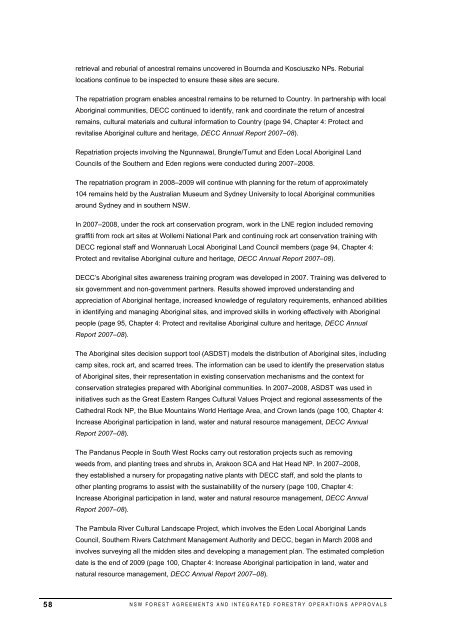Progress Report 2007-2008 - Department of Environment and ...
Progress Report 2007-2008 - Department of Environment and ...
Progress Report 2007-2008 - Department of Environment and ...
You also want an ePaper? Increase the reach of your titles
YUMPU automatically turns print PDFs into web optimized ePapers that Google loves.
58<br />
retrieval <strong>and</strong> reburial <strong>of</strong> ancestral remains uncovered in Bournda <strong>and</strong> Kosciuszko NPs. Reburial<br />
locations continue to be inspected to ensure these sites are secure.<br />
The repatriation program enables ancestral remains to be returned to Country. In partnership with local<br />
Aboriginal communities, DECC continued to identify, rank <strong>and</strong> coordinate the return <strong>of</strong> ancestral<br />
remains, cultural materials <strong>and</strong> cultural information to Country (page 94, Chapter 4: Protect <strong>and</strong><br />
revitalise Aboriginal culture <strong>and</strong> heritage, DECC Annual <strong>Report</strong> <strong>2007</strong>–08).<br />
Repatriation projects involving the Ngunnawal, Brungle/Tumut <strong>and</strong> Eden Local Aboriginal L<strong>and</strong><br />
Councils <strong>of</strong> the Southern <strong>and</strong> Eden regions were conducted during <strong>2007</strong>–<strong>2008</strong>.<br />
The repatriation program in <strong>2008</strong>–2009 will continue with planning for the return <strong>of</strong> approximately<br />
104 remains held by the Australian Museum <strong>and</strong> Sydney University to local Aboriginal communities<br />
around Sydney <strong>and</strong> in southern NSW.<br />
In <strong>2007</strong>–<strong>2008</strong>, under the rock art conservation program, work in the LNE region included removing<br />
graffiti from rock art sites at Wollemi National Park <strong>and</strong> continuing rock art conservation training with<br />
DECC regional staff <strong>and</strong> Wonnaruah Local Aboriginal L<strong>and</strong> Council members (page 94, Chapter 4:<br />
Protect <strong>and</strong> revitalise Aboriginal culture <strong>and</strong> heritage, DECC Annual <strong>Report</strong> <strong>2007</strong>–08).<br />
DECC’s Aboriginal sites awareness training program was developed in <strong>2007</strong>. Training was delivered to<br />
six government <strong>and</strong> non-government partners. Results showed improved underst<strong>and</strong>ing <strong>and</strong><br />
appreciation <strong>of</strong> Aboriginal heritage, increased knowledge <strong>of</strong> regulatory requirements, enhanced abilities<br />
in identifying <strong>and</strong> managing Aboriginal sites, <strong>and</strong> improved skills in working effectively with Aboriginal<br />
people (page 95, Chapter 4: Protect <strong>and</strong> revitalise Aboriginal culture <strong>and</strong> heritage, DECC Annual<br />
<strong>Report</strong> <strong>2007</strong>–08).<br />
The Aboriginal sites decision support tool (ASDST) models the distribution <strong>of</strong> Aboriginal sites, including<br />
camp sites, rock art, <strong>and</strong> scarred trees. The information can be used to identify the preservation status<br />
<strong>of</strong> Aboriginal sites, their representation in existing conservation mechanisms <strong>and</strong> the context for<br />
conservation strategies prepared with Aboriginal communities. In <strong>2007</strong>–<strong>2008</strong>, ASDST was used in<br />
initiatives such as the Great Eastern Ranges Cultural Values Project <strong>and</strong> regional assessments <strong>of</strong> the<br />
Cathedral Rock NP, the Blue Mountains World Heritage Area, <strong>and</strong> Crown l<strong>and</strong>s (page 100, Chapter 4:<br />
Increase Aboriginal participation in l<strong>and</strong>, water <strong>and</strong> natural resource management, DECC Annual<br />
<strong>Report</strong> <strong>2007</strong>–08).<br />
The P<strong>and</strong>anus People in South West Rocks carry out restoration projects such as removing<br />
weeds from, <strong>and</strong> planting trees <strong>and</strong> shrubs in, Arakoon SCA <strong>and</strong> Hat Head NP. In <strong>2007</strong>–<strong>2008</strong>,<br />
they established a nursery for propagating native plants with DECC staff, <strong>and</strong> sold the plants to<br />
other planting programs to assist with the sustainability <strong>of</strong> the nursery (page 100, Chapter 4:<br />
Increase Aboriginal participation in l<strong>and</strong>, water <strong>and</strong> natural resource management, DECC Annual<br />
<strong>Report</strong> <strong>2007</strong>–08).<br />
The Pambula River Cultural L<strong>and</strong>scape Project, which involves the Eden Local Aboriginal L<strong>and</strong>s<br />
Council, Southern Rivers Catchment Management Authority <strong>and</strong> DECC, began in March <strong>2008</strong> <strong>and</strong><br />
involves surveying all the midden sites <strong>and</strong> developing a management plan. The estimated completion<br />
date is the end <strong>of</strong> 2009 (page 100, Chapter 4: Increase Aboriginal participation in l<strong>and</strong>, water <strong>and</strong><br />
natural resource management, DECC Annual <strong>Report</strong> <strong>2007</strong>–08).<br />
NSW FOREST AGREEMENTS AND INTEGRATED FORESTRY OPERATIONS APPROVALS

















